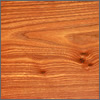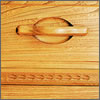|
|
||||
|
|
American red elm (Ulmus rubra)Other names: Slippery elm, brown elm
Click to enlarge DistributionThe Eastern to Mid-West USA. General descriptionRed elm has a greyish white to light brown narrow sapwood, with heartwood that is reddish brown to dark brown in colour. The grain can be straight, but is often interlocked. The wood has a coarse texture. (American grey elm is now only available in very limited volume.) Working propertiesThe wood of red elm is fairly easy to work, it nails, screws and glues well, and can be sanded, stained and polished to a good finish. It dries well with minimum degrade and little movement in performance.
Physical propertiesElm is moderately heavy, hard and stiff with excellent bending and shock resistance. It is difficult to split because of its interlocked grain. Specific Gravity: 0.53 (12% M.C.) DurabilityRated as non-resistant to heartwood decay, and classed as permeable to preservatives. AvailabilityUSA: Limited in both lumber and veneer as supply is threatened
by Dutch elm disease, but more available in the south. Main usesFurniture, cabinet making, flooring, internal joinery, panelling and coffins.
|
|
||||||||||||||||||||||||||||||||||||||||||||||||||||||||||||||||||||||||||||




